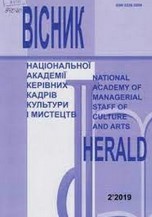AESTHETIC DIMENSION OF SACRED MONODY IN CULTURAL AND EDUCATIONAL ENVIRONMENT IN UKRAINE IN 17TH CENTURY
AESTHETIC DIMENSION OF SACRED MONODY IN CULTURAL AND EDUCATIONAL ENVIRONMENT IN UKRAINE IN 17TH CENTURY
Author(s): Svitlana Huralna, Natalia SyrotynskaSubject(s): Music, History of Church(es), Aesthetics, History of Education, 17th Century
Published by: Національна академія керівних кадрів культури і мистецтв
Keywords: aesthetics; sacred monody; neumes; five-line notation; medieval singing; colophonic style; irmologion; church music education;
Summary/Abstract: The purpose of the article. The paper is devoted to the influence of the Greek-Byzantine spiritual heritage on the Ukrainian cultural and educational environment. The methodology of the study uses the historical-chronological method to reproduce the sequence of development of the sacred monody in European culture, primarily in Ukraine. The method of analysis and comparison has been used to identify common and distinctive international features of the development of sacred monody. The method of material synthesis helped summarise all the important conditions for the development of Ukrainian monophonic singing. The scientific novelty of the work is that it consistently examines the influence Byzantine monody on Ukrainian liturgical practice. The study is based on the practice of colophonic style of the Byzantine sacred monody. Conclusions. The aesthetic canons of the Greek-Byzantine spiritual culture were fully adapted with the Christian rite and reflected in the sacred monody. In the future, this determined the implementation of important church and educational reforms in the 16th century and the development of all layers of Ukrainian culture. At the same time, educational centres were developed, and printing houses at brotherly schools provided schoolchildren with the necessary textbooks. And what is important, all children without exception already at the initial stage of education got to know and studied the first notated collections of sacred monody, spreading the ancient traditions of singing in all social strata of society.
Journal: Вісник Національної академії керівних кадрів культури і мистецтв
- Issue Year: 2022
- Issue No: 4
- Page Range: 79-84
- Page Count: 6
- Language: English

